Analyzing Consumer Behavior: Decision Process and Cultural Influence
VerifiedAdded on 2020/07/22
|9
|2586
|31
Report
AI Summary
This report provides a detailed analysis of consumer behavior, focusing on the intricacies of the consumer decision-making process and the influence of cultural dimensions. It begins by explaining the various stages consumers go through when making purchasing decisions, including need recognition, information search, evaluation of alternatives, purchase, and post-purchase behavior. The report then delves into two key cultural dimensions: nationality and ethnicity, exploring how these factors shape consumer preferences, values, and ultimately, buying behavior. It evaluates how these dimensions interact, using examples like McDonald's adaptation to local cultures, and how businesses must consider cultural nuances to effectively market their products. The report emphasizes the importance of understanding consumer needs, ethical considerations, and the impact of social influences on consumer choices, concluding that a deep understanding of these factors is critical for successful business strategies. The report uses academic sources to support its claims and provides a comprehensive overview of the subject.
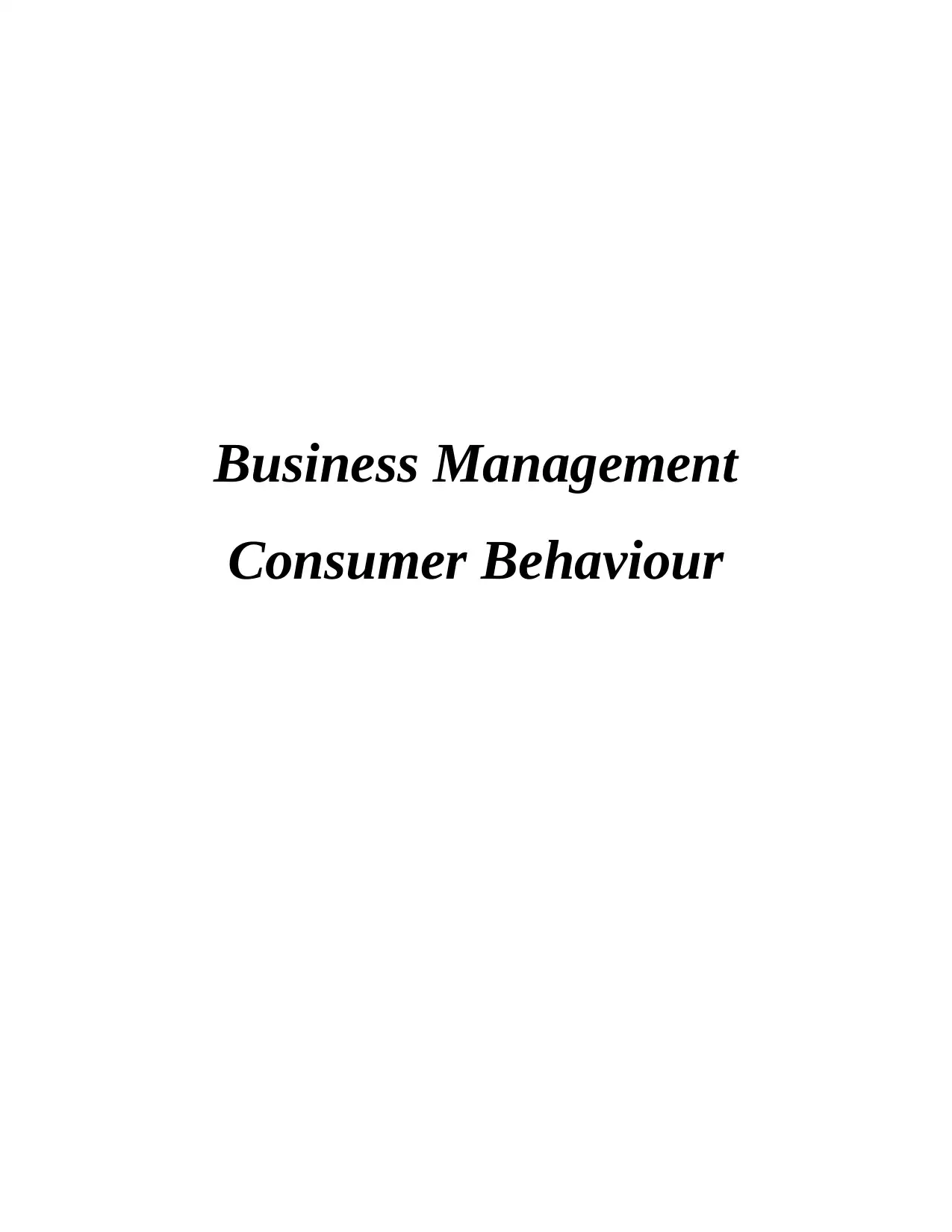
Business Management
Consumer Behaviour
Consumer Behaviour
Secure Best Marks with AI Grader
Need help grading? Try our AI Grader for instant feedback on your assignments.
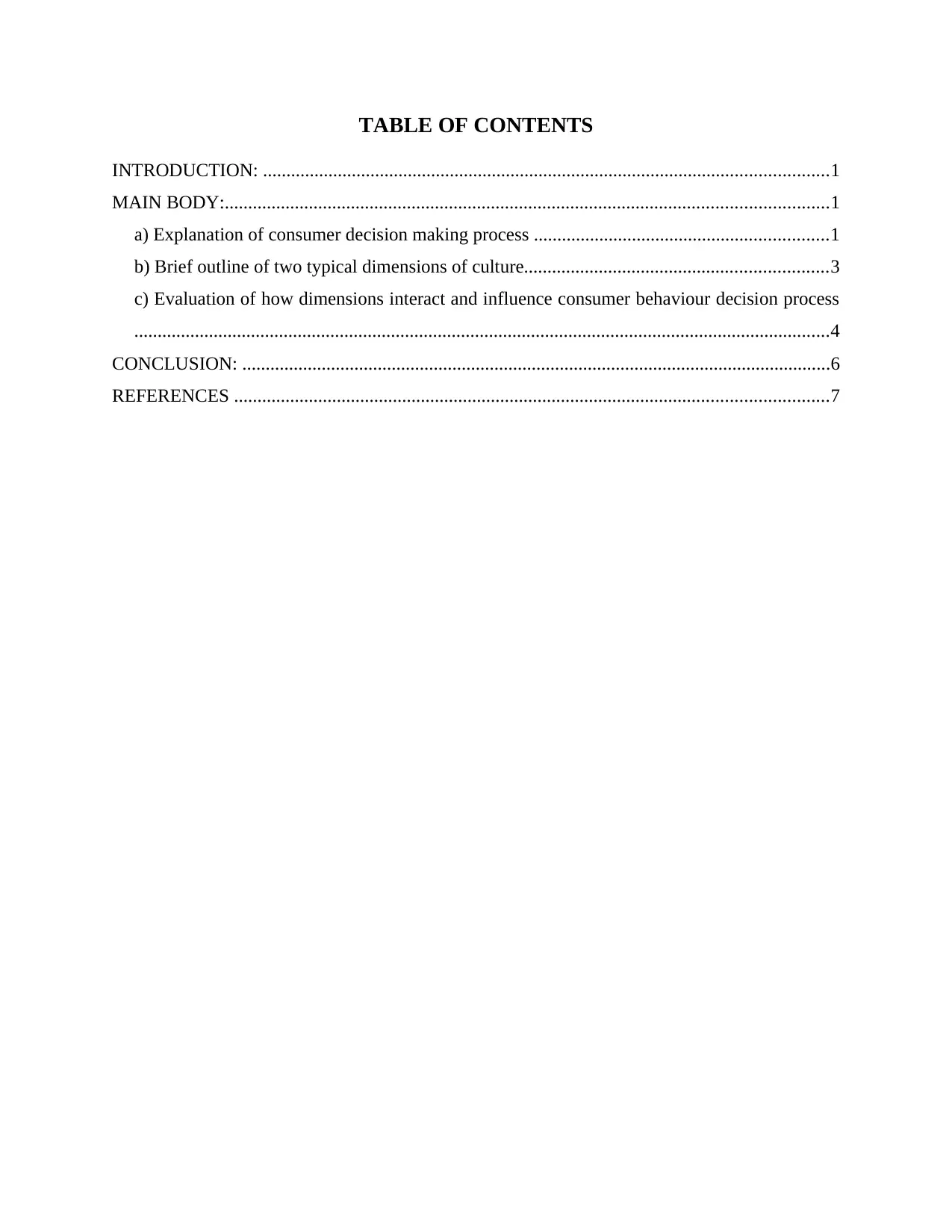
TABLE OF CONTENTS
INTRODUCTION: .........................................................................................................................1
MAIN BODY:.................................................................................................................................1
a) Explanation of consumer decision making process ...............................................................1
b) Brief outline of two typical dimensions of culture.................................................................3
c) Evaluation of how dimensions interact and influence consumer behaviour decision process
.....................................................................................................................................................4
CONCLUSION: ..............................................................................................................................6
REFERENCES ...............................................................................................................................7
INTRODUCTION: .........................................................................................................................1
MAIN BODY:.................................................................................................................................1
a) Explanation of consumer decision making process ...............................................................1
b) Brief outline of two typical dimensions of culture.................................................................3
c) Evaluation of how dimensions interact and influence consumer behaviour decision process
.....................................................................................................................................................4
CONCLUSION: ..............................................................................................................................6
REFERENCES ...............................................................................................................................7
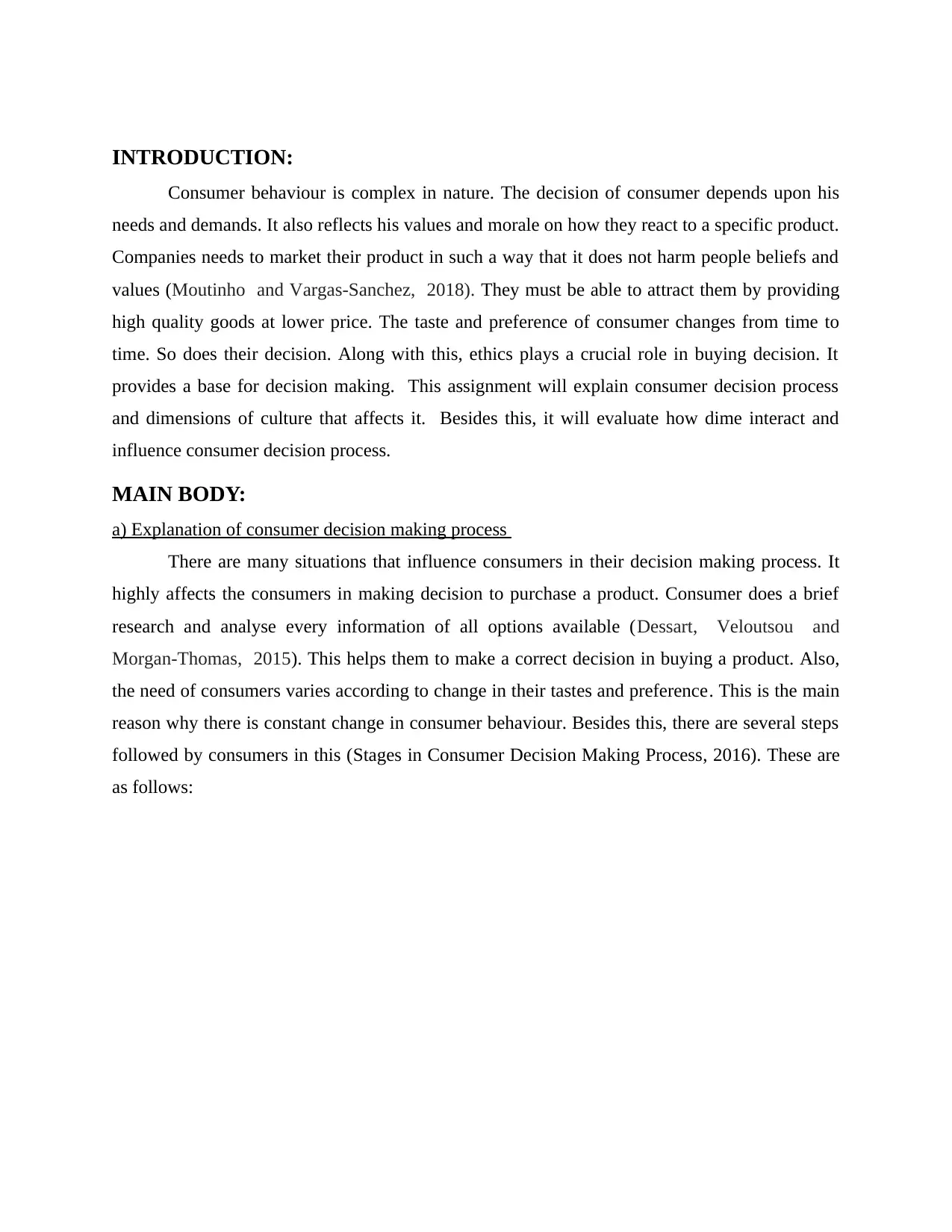
INTRODUCTION:
Consumer behaviour is complex in nature. The decision of consumer depends upon his
needs and demands. It also reflects his values and morale on how they react to a specific product.
Companies needs to market their product in such a way that it does not harm people beliefs and
values (Moutinho and Vargas-Sanchez, 2018). They must be able to attract them by providing
high quality goods at lower price. The taste and preference of consumer changes from time to
time. So does their decision. Along with this, ethics plays a crucial role in buying decision. It
provides a base for decision making. This assignment will explain consumer decision process
and dimensions of culture that affects it. Besides this, it will evaluate how dime interact and
influence consumer decision process.
MAIN BODY:
a) Explanation of consumer decision making process
There are many situations that influence consumers in their decision making process. It
highly affects the consumers in making decision to purchase a product. Consumer does a brief
research and analyse every information of all options available (Dessart, Veloutsou and
Morgan-Thomas, 2015). This helps them to make a correct decision in buying a product. Also,
the need of consumers varies according to change in their tastes and preference. This is the main
reason why there is constant change in consumer behaviour. Besides this, there are several steps
followed by consumers in this (Stages in Consumer Decision Making Process, 2016). These are
as follows:
Consumer behaviour is complex in nature. The decision of consumer depends upon his
needs and demands. It also reflects his values and morale on how they react to a specific product.
Companies needs to market their product in such a way that it does not harm people beliefs and
values (Moutinho and Vargas-Sanchez, 2018). They must be able to attract them by providing
high quality goods at lower price. The taste and preference of consumer changes from time to
time. So does their decision. Along with this, ethics plays a crucial role in buying decision. It
provides a base for decision making. This assignment will explain consumer decision process
and dimensions of culture that affects it. Besides this, it will evaluate how dime interact and
influence consumer decision process.
MAIN BODY:
a) Explanation of consumer decision making process
There are many situations that influence consumers in their decision making process. It
highly affects the consumers in making decision to purchase a product. Consumer does a brief
research and analyse every information of all options available (Dessart, Veloutsou and
Morgan-Thomas, 2015). This helps them to make a correct decision in buying a product. Also,
the need of consumers varies according to change in their tastes and preference. This is the main
reason why there is constant change in consumer behaviour. Besides this, there are several steps
followed by consumers in this (Stages in Consumer Decision Making Process, 2016). These are
as follows:
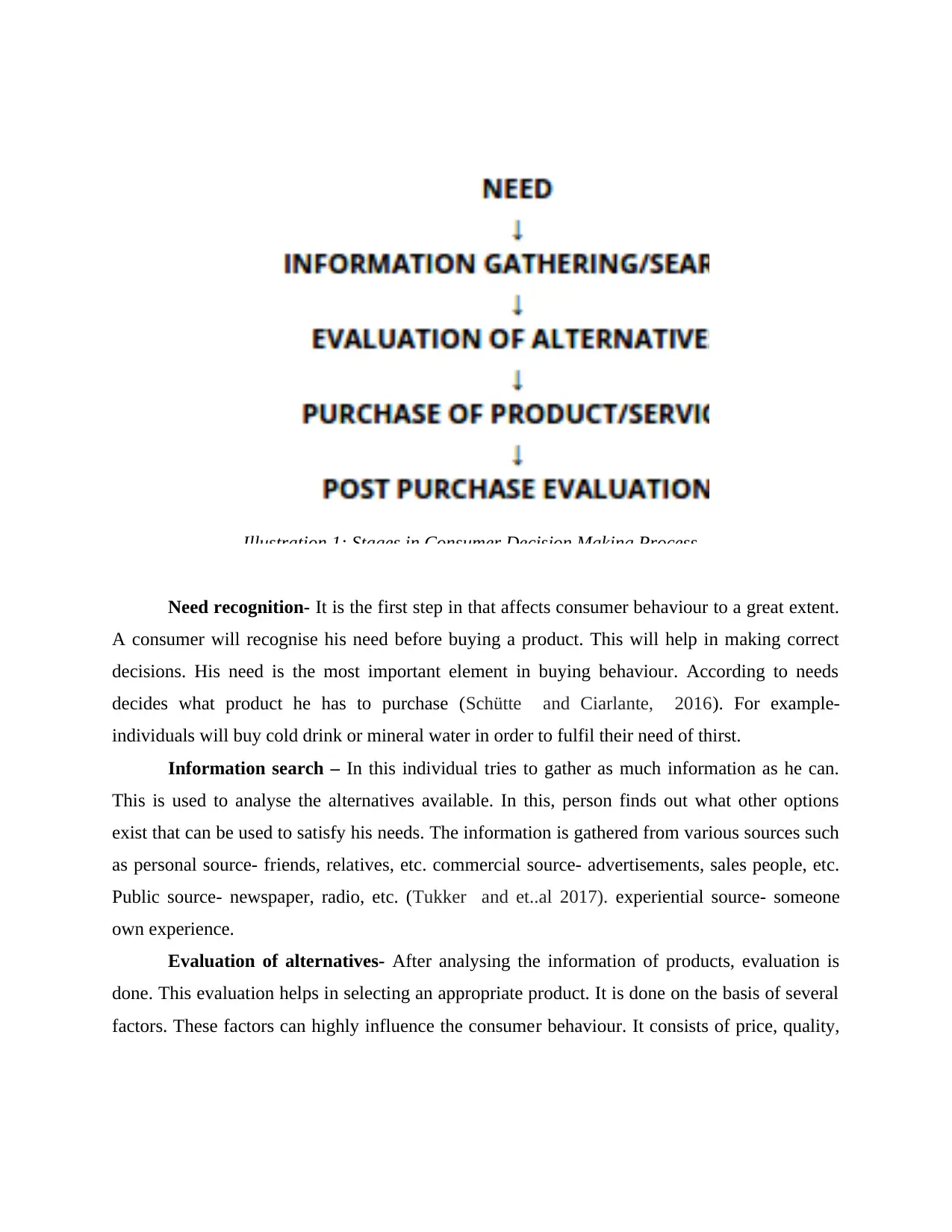
Need recognition- It is the first step in that affects consumer behaviour to a great extent.
A consumer will recognise his need before buying a product. This will help in making correct
decisions. His need is the most important element in buying behaviour. According to needs
decides what product he has to purchase (Schütte and Ciarlante, 2016). For example-
individuals will buy cold drink or mineral water in order to fulfil their need of thirst.
Information search – In this individual tries to gather as much information as he can.
This is used to analyse the alternatives available. In this, person finds out what other options
exist that can be used to satisfy his needs. The information is gathered from various sources such
as personal source- friends, relatives, etc. commercial source- advertisements, sales people, etc.
Public source- newspaper, radio, etc. (Tukker and et..al 2017). experiential source- someone
own experience.
Evaluation of alternatives- After analysing the information of products, evaluation is
done. This evaluation helps in selecting an appropriate product. It is done on the basis of several
factors. These factors can highly influence the consumer behaviour. It consists of price, quality,
Illustration 1: Stages in Consumer Decision Making Process
A consumer will recognise his need before buying a product. This will help in making correct
decisions. His need is the most important element in buying behaviour. According to needs
decides what product he has to purchase (Schütte and Ciarlante, 2016). For example-
individuals will buy cold drink or mineral water in order to fulfil their need of thirst.
Information search – In this individual tries to gather as much information as he can.
This is used to analyse the alternatives available. In this, person finds out what other options
exist that can be used to satisfy his needs. The information is gathered from various sources such
as personal source- friends, relatives, etc. commercial source- advertisements, sales people, etc.
Public source- newspaper, radio, etc. (Tukker and et..al 2017). experiential source- someone
own experience.
Evaluation of alternatives- After analysing the information of products, evaluation is
done. This evaluation helps in selecting an appropriate product. It is done on the basis of several
factors. These factors can highly influence the consumer behaviour. It consists of price, quality,
Illustration 1: Stages in Consumer Decision Making Process
Secure Best Marks with AI Grader
Need help grading? Try our AI Grader for instant feedback on your assignments.
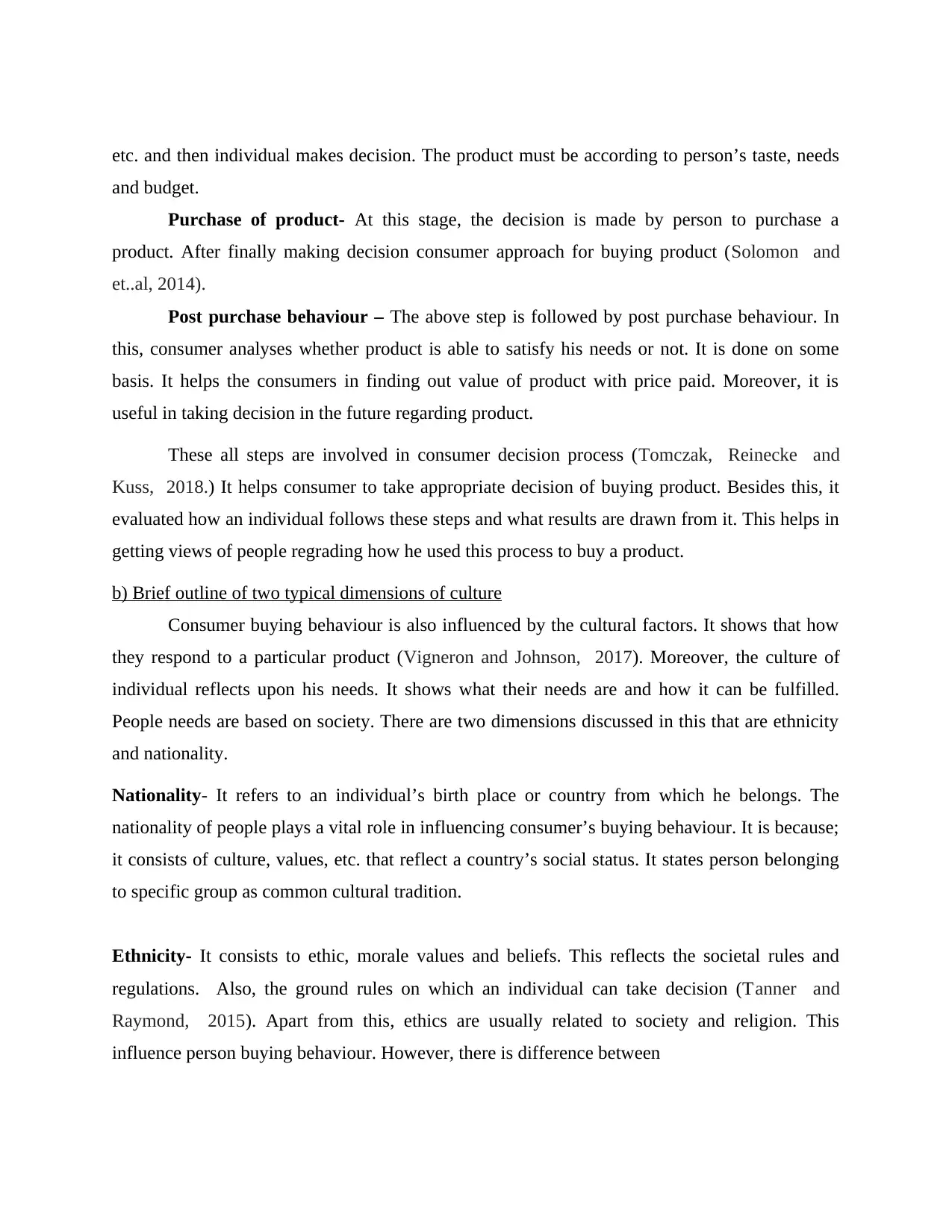
etc. and then individual makes decision. The product must be according to person’s taste, needs
and budget.
Purchase of product- At this stage, the decision is made by person to purchase a
product. After finally making decision consumer approach for buying product (Solomon and
et..al, 2014).
Post purchase behaviour – The above step is followed by post purchase behaviour. In
this, consumer analyses whether product is able to satisfy his needs or not. It is done on some
basis. It helps the consumers in finding out value of product with price paid. Moreover, it is
useful in taking decision in the future regarding product.
These all steps are involved in consumer decision process (Tomczak, Reinecke and
Kuss, 2018.) It helps consumer to take appropriate decision of buying product. Besides this, it
evaluated how an individual follows these steps and what results are drawn from it. This helps in
getting views of people regrading how he used this process to buy a product.
b) Brief outline of two typical dimensions of culture
Consumer buying behaviour is also influenced by the cultural factors. It shows that how
they respond to a particular product (Vigneron and Johnson, 2017). Moreover, the culture of
individual reflects upon his needs. It shows what their needs are and how it can be fulfilled.
People needs are based on society. There are two dimensions discussed in this that are ethnicity
and nationality.
Nationality- It refers to an individual’s birth place or country from which he belongs. The
nationality of people plays a vital role in influencing consumer’s buying behaviour. It is because;
it consists of culture, values, etc. that reflect a country’s social status. It states person belonging
to specific group as common cultural tradition.
Ethnicity- It consists to ethic, morale values and beliefs. This reflects the societal rules and
regulations. Also, the ground rules on which an individual can take decision (Tanner and
Raymond, 2015). Apart from this, ethics are usually related to society and religion. This
influence person buying behaviour. However, there is difference between
and budget.
Purchase of product- At this stage, the decision is made by person to purchase a
product. After finally making decision consumer approach for buying product (Solomon and
et..al, 2014).
Post purchase behaviour – The above step is followed by post purchase behaviour. In
this, consumer analyses whether product is able to satisfy his needs or not. It is done on some
basis. It helps the consumers in finding out value of product with price paid. Moreover, it is
useful in taking decision in the future regarding product.
These all steps are involved in consumer decision process (Tomczak, Reinecke and
Kuss, 2018.) It helps consumer to take appropriate decision of buying product. Besides this, it
evaluated how an individual follows these steps and what results are drawn from it. This helps in
getting views of people regrading how he used this process to buy a product.
b) Brief outline of two typical dimensions of culture
Consumer buying behaviour is also influenced by the cultural factors. It shows that how
they respond to a particular product (Vigneron and Johnson, 2017). Moreover, the culture of
individual reflects upon his needs. It shows what their needs are and how it can be fulfilled.
People needs are based on society. There are two dimensions discussed in this that are ethnicity
and nationality.
Nationality- It refers to an individual’s birth place or country from which he belongs. The
nationality of people plays a vital role in influencing consumer’s buying behaviour. It is because;
it consists of culture, values, etc. that reflect a country’s social status. It states person belonging
to specific group as common cultural tradition.
Ethnicity- It consists to ethic, morale values and beliefs. This reflects the societal rules and
regulations. Also, the ground rules on which an individual can take decision (Tanner and
Raymond, 2015). Apart from this, ethics are usually related to society and religion. This
influence person buying behaviour. However, there is difference between
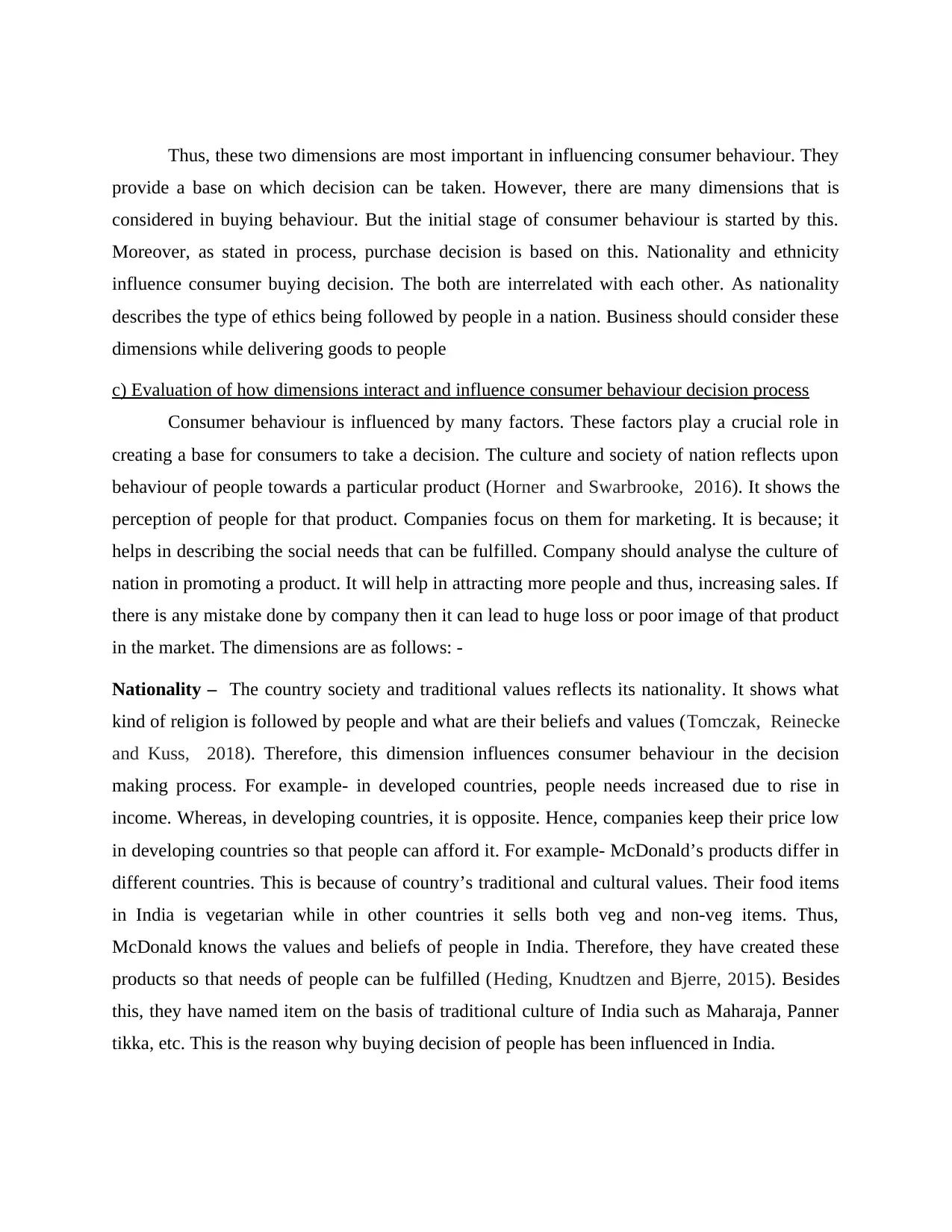
Thus, these two dimensions are most important in influencing consumer behaviour. They
provide a base on which decision can be taken. However, there are many dimensions that is
considered in buying behaviour. But the initial stage of consumer behaviour is started by this.
Moreover, as stated in process, purchase decision is based on this. Nationality and ethnicity
influence consumer buying decision. The both are interrelated with each other. As nationality
describes the type of ethics being followed by people in a nation. Business should consider these
dimensions while delivering goods to people
c) Evaluation of how dimensions interact and influence consumer behaviour decision process
Consumer behaviour is influenced by many factors. These factors play a crucial role in
creating a base for consumers to take a decision. The culture and society of nation reflects upon
behaviour of people towards a particular product (Horner and Swarbrooke, 2016). It shows the
perception of people for that product. Companies focus on them for marketing. It is because; it
helps in describing the social needs that can be fulfilled. Company should analyse the culture of
nation in promoting a product. It will help in attracting more people and thus, increasing sales. If
there is any mistake done by company then it can lead to huge loss or poor image of that product
in the market. The dimensions are as follows: -
Nationality – The country society and traditional values reflects its nationality. It shows what
kind of religion is followed by people and what are their beliefs and values (Tomczak, Reinecke
and Kuss, 2018). Therefore, this dimension influences consumer behaviour in the decision
making process. For example- in developed countries, people needs increased due to rise in
income. Whereas, in developing countries, it is opposite. Hence, companies keep their price low
in developing countries so that people can afford it. For example- McDonald’s products differ in
different countries. This is because of country’s traditional and cultural values. Their food items
in India is vegetarian while in other countries it sells both veg and non-veg items. Thus,
McDonald knows the values and beliefs of people in India. Therefore, they have created these
products so that needs of people can be fulfilled (Heding, Knudtzen and Bjerre, 2015). Besides
this, they have named item on the basis of traditional culture of India such as Maharaja, Panner
tikka, etc. This is the reason why buying decision of people has been influenced in India.
provide a base on which decision can be taken. However, there are many dimensions that is
considered in buying behaviour. But the initial stage of consumer behaviour is started by this.
Moreover, as stated in process, purchase decision is based on this. Nationality and ethnicity
influence consumer buying decision. The both are interrelated with each other. As nationality
describes the type of ethics being followed by people in a nation. Business should consider these
dimensions while delivering goods to people
c) Evaluation of how dimensions interact and influence consumer behaviour decision process
Consumer behaviour is influenced by many factors. These factors play a crucial role in
creating a base for consumers to take a decision. The culture and society of nation reflects upon
behaviour of people towards a particular product (Horner and Swarbrooke, 2016). It shows the
perception of people for that product. Companies focus on them for marketing. It is because; it
helps in describing the social needs that can be fulfilled. Company should analyse the culture of
nation in promoting a product. It will help in attracting more people and thus, increasing sales. If
there is any mistake done by company then it can lead to huge loss or poor image of that product
in the market. The dimensions are as follows: -
Nationality – The country society and traditional values reflects its nationality. It shows what
kind of religion is followed by people and what are their beliefs and values (Tomczak, Reinecke
and Kuss, 2018). Therefore, this dimension influences consumer behaviour in the decision
making process. For example- in developed countries, people needs increased due to rise in
income. Whereas, in developing countries, it is opposite. Hence, companies keep their price low
in developing countries so that people can afford it. For example- McDonald’s products differ in
different countries. This is because of country’s traditional and cultural values. Their food items
in India is vegetarian while in other countries it sells both veg and non-veg items. Thus,
McDonald knows the values and beliefs of people in India. Therefore, they have created these
products so that needs of people can be fulfilled (Heding, Knudtzen and Bjerre, 2015). Besides
this, they have named item on the basis of traditional culture of India such as Maharaja, Panner
tikka, etc. This is the reason why buying decision of people has been influenced in India.
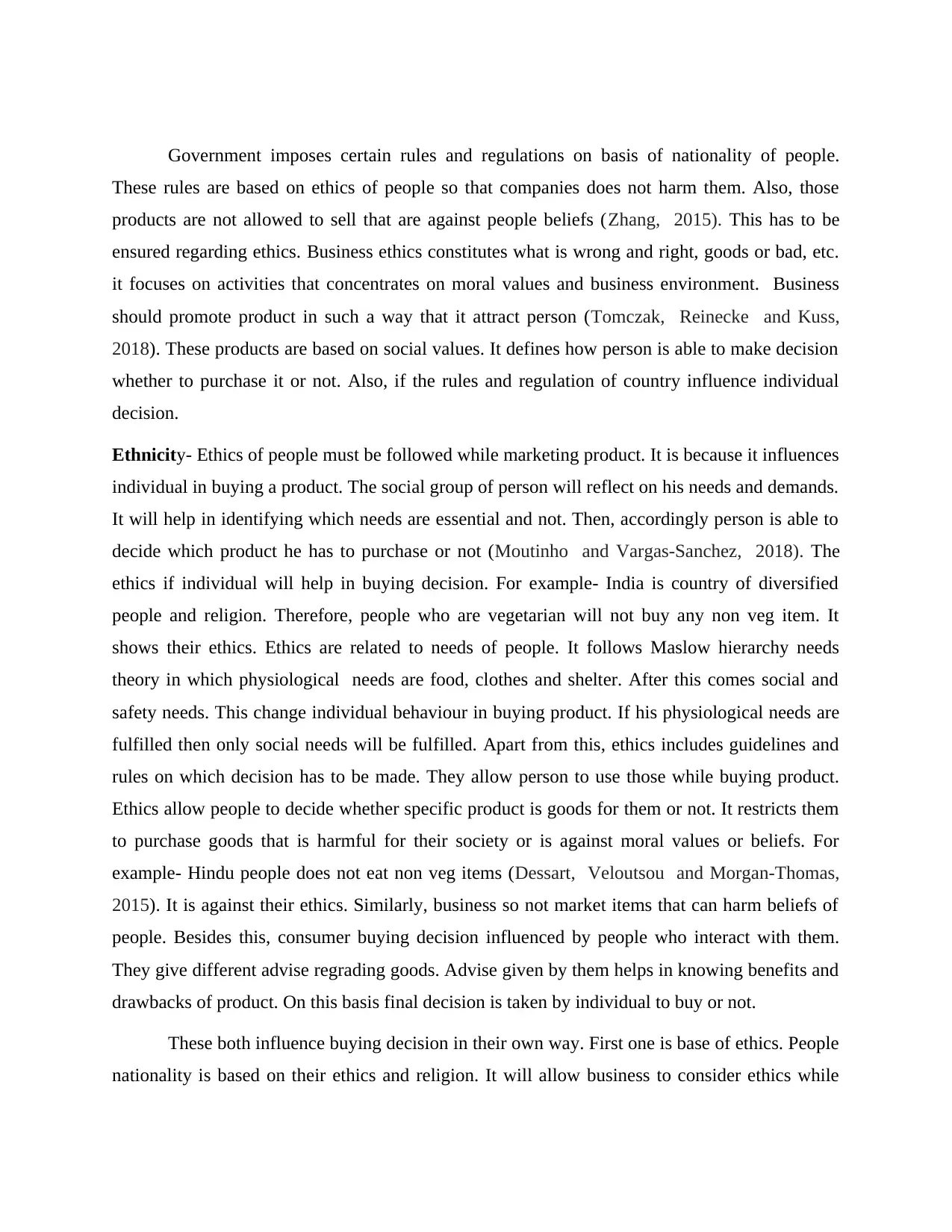
Government imposes certain rules and regulations on basis of nationality of people.
These rules are based on ethics of people so that companies does not harm them. Also, those
products are not allowed to sell that are against people beliefs (Zhang, 2015). This has to be
ensured regarding ethics. Business ethics constitutes what is wrong and right, goods or bad, etc.
it focuses on activities that concentrates on moral values and business environment. Business
should promote product in such a way that it attract person (Tomczak, Reinecke and Kuss,
2018). These products are based on social values. It defines how person is able to make decision
whether to purchase it or not. Also, if the rules and regulation of country influence individual
decision.
Ethnicity- Ethics of people must be followed while marketing product. It is because it influences
individual in buying a product. The social group of person will reflect on his needs and demands.
It will help in identifying which needs are essential and not. Then, accordingly person is able to
decide which product he has to purchase or not (Moutinho and Vargas-Sanchez, 2018). The
ethics if individual will help in buying decision. For example- India is country of diversified
people and religion. Therefore, people who are vegetarian will not buy any non veg item. It
shows their ethics. Ethics are related to needs of people. It follows Maslow hierarchy needs
theory in which physiological needs are food, clothes and shelter. After this comes social and
safety needs. This change individual behaviour in buying product. If his physiological needs are
fulfilled then only social needs will be fulfilled. Apart from this, ethics includes guidelines and
rules on which decision has to be made. They allow person to use those while buying product.
Ethics allow people to decide whether specific product is goods for them or not. It restricts them
to purchase goods that is harmful for their society or is against moral values or beliefs. For
example- Hindu people does not eat non veg items (Dessart, Veloutsou and Morgan-Thomas,
2015). It is against their ethics. Similarly, business so not market items that can harm beliefs of
people. Besides this, consumer buying decision influenced by people who interact with them.
They give different advise regrading goods. Advise given by them helps in knowing benefits and
drawbacks of product. On this basis final decision is taken by individual to buy or not.
These both influence buying decision in their own way. First one is base of ethics. People
nationality is based on their ethics and religion. It will allow business to consider ethics while
These rules are based on ethics of people so that companies does not harm them. Also, those
products are not allowed to sell that are against people beliefs (Zhang, 2015). This has to be
ensured regarding ethics. Business ethics constitutes what is wrong and right, goods or bad, etc.
it focuses on activities that concentrates on moral values and business environment. Business
should promote product in such a way that it attract person (Tomczak, Reinecke and Kuss,
2018). These products are based on social values. It defines how person is able to make decision
whether to purchase it or not. Also, if the rules and regulation of country influence individual
decision.
Ethnicity- Ethics of people must be followed while marketing product. It is because it influences
individual in buying a product. The social group of person will reflect on his needs and demands.
It will help in identifying which needs are essential and not. Then, accordingly person is able to
decide which product he has to purchase or not (Moutinho and Vargas-Sanchez, 2018). The
ethics if individual will help in buying decision. For example- India is country of diversified
people and religion. Therefore, people who are vegetarian will not buy any non veg item. It
shows their ethics. Ethics are related to needs of people. It follows Maslow hierarchy needs
theory in which physiological needs are food, clothes and shelter. After this comes social and
safety needs. This change individual behaviour in buying product. If his physiological needs are
fulfilled then only social needs will be fulfilled. Apart from this, ethics includes guidelines and
rules on which decision has to be made. They allow person to use those while buying product.
Ethics allow people to decide whether specific product is goods for them or not. It restricts them
to purchase goods that is harmful for their society or is against moral values or beliefs. For
example- Hindu people does not eat non veg items (Dessart, Veloutsou and Morgan-Thomas,
2015). It is against their ethics. Similarly, business so not market items that can harm beliefs of
people. Besides this, consumer buying decision influenced by people who interact with them.
They give different advise regrading goods. Advise given by them helps in knowing benefits and
drawbacks of product. On this basis final decision is taken by individual to buy or not.
These both influence buying decision in their own way. First one is base of ethics. People
nationality is based on their ethics and religion. It will allow business to consider ethics while
Paraphrase This Document
Need a fresh take? Get an instant paraphrase of this document with our AI Paraphraser
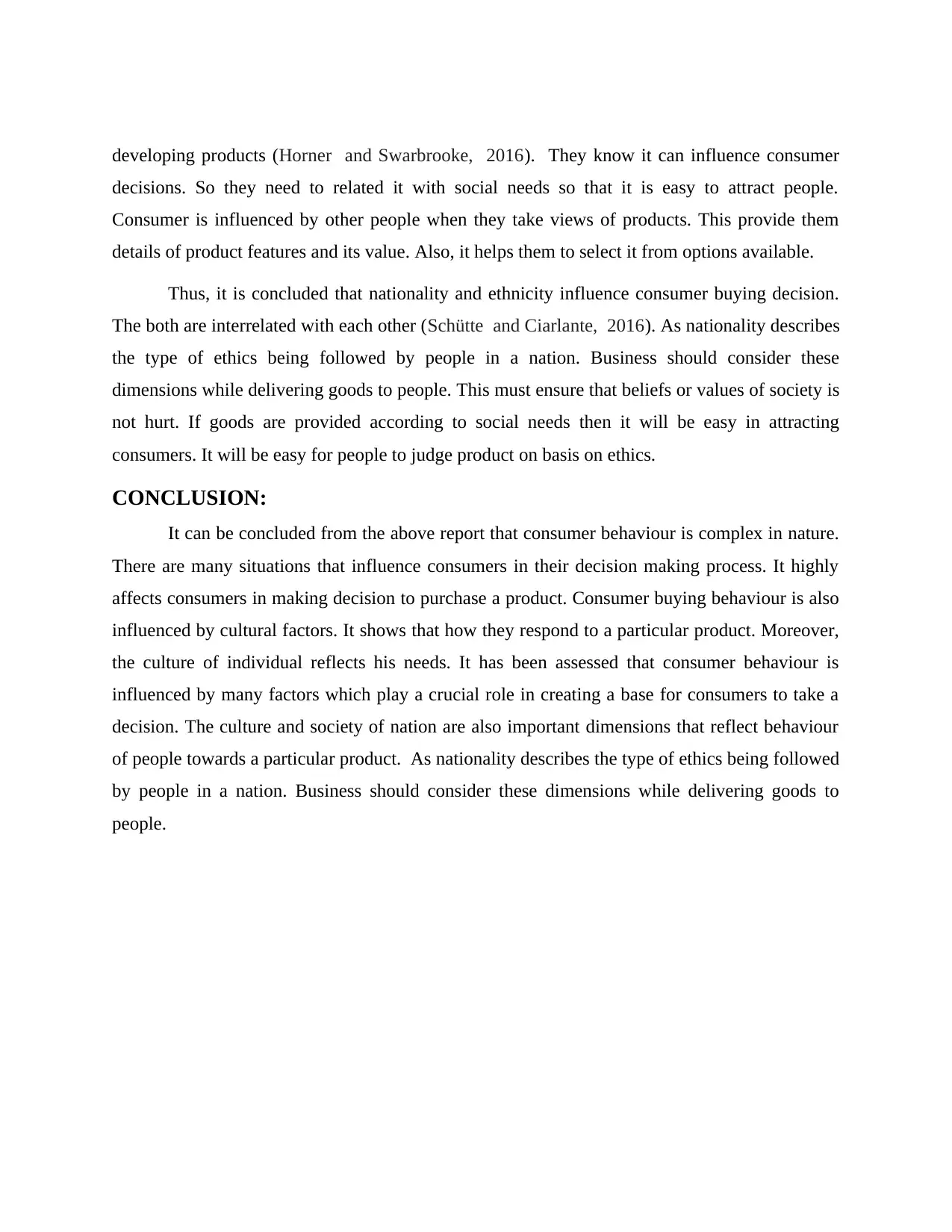
developing products (Horner and Swarbrooke, 2016). They know it can influence consumer
decisions. So they need to related it with social needs so that it is easy to attract people.
Consumer is influenced by other people when they take views of products. This provide them
details of product features and its value. Also, it helps them to select it from options available.
Thus, it is concluded that nationality and ethnicity influence consumer buying decision.
The both are interrelated with each other (Schütte and Ciarlante, 2016). As nationality describes
the type of ethics being followed by people in a nation. Business should consider these
dimensions while delivering goods to people. This must ensure that beliefs or values of society is
not hurt. If goods are provided according to social needs then it will be easy in attracting
consumers. It will be easy for people to judge product on basis on ethics.
CONCLUSION:
It can be concluded from the above report that consumer behaviour is complex in nature.
There are many situations that influence consumers in their decision making process. It highly
affects consumers in making decision to purchase a product. Consumer buying behaviour is also
influenced by cultural factors. It shows that how they respond to a particular product. Moreover,
the culture of individual reflects his needs. It has been assessed that consumer behaviour is
influenced by many factors which play a crucial role in creating a base for consumers to take a
decision. The culture and society of nation are also important dimensions that reflect behaviour
of people towards a particular product. As nationality describes the type of ethics being followed
by people in a nation. Business should consider these dimensions while delivering goods to
people.
decisions. So they need to related it with social needs so that it is easy to attract people.
Consumer is influenced by other people when they take views of products. This provide them
details of product features and its value. Also, it helps them to select it from options available.
Thus, it is concluded that nationality and ethnicity influence consumer buying decision.
The both are interrelated with each other (Schütte and Ciarlante, 2016). As nationality describes
the type of ethics being followed by people in a nation. Business should consider these
dimensions while delivering goods to people. This must ensure that beliefs or values of society is
not hurt. If goods are provided according to social needs then it will be easy in attracting
consumers. It will be easy for people to judge product on basis on ethics.
CONCLUSION:
It can be concluded from the above report that consumer behaviour is complex in nature.
There are many situations that influence consumers in their decision making process. It highly
affects consumers in making decision to purchase a product. Consumer buying behaviour is also
influenced by cultural factors. It shows that how they respond to a particular product. Moreover,
the culture of individual reflects his needs. It has been assessed that consumer behaviour is
influenced by many factors which play a crucial role in creating a base for consumers to take a
decision. The culture and society of nation are also important dimensions that reflect behaviour
of people towards a particular product. As nationality describes the type of ethics being followed
by people in a nation. Business should consider these dimensions while delivering goods to
people.
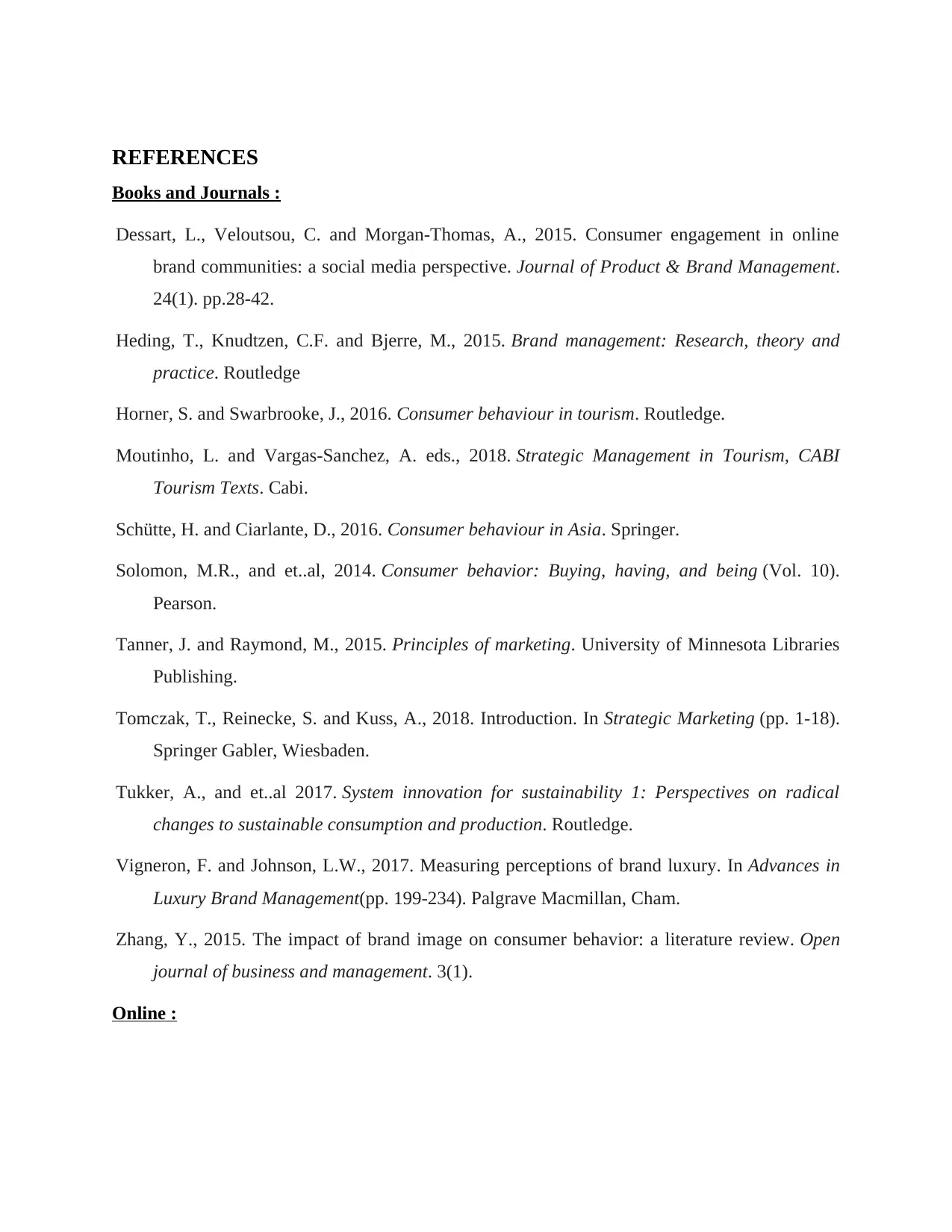
REFERENCES
Books and Journals :
Dessart, L., Veloutsou, C. and Morgan-Thomas, A., 2015. Consumer engagement in online
brand communities: a social media perspective. Journal of Product & Brand Management.
24(1). pp.28-42.
Heding, T., Knudtzen, C.F. and Bjerre, M., 2015. Brand management: Research, theory and
practice. Routledge
Horner, S. and Swarbrooke, J., 2016. Consumer behaviour in tourism. Routledge.
Moutinho, L. and Vargas-Sanchez, A. eds., 2018. Strategic Management in Tourism, CABI
Tourism Texts. Cabi.
Schütte, H. and Ciarlante, D., 2016. Consumer behaviour in Asia. Springer.
Solomon, M.R., and et..al, 2014. Consumer behavior: Buying, having, and being (Vol. 10).
Pearson.
Tanner, J. and Raymond, M., 2015. Principles of marketing. University of Minnesota Libraries
Publishing.
Tomczak, T., Reinecke, S. and Kuss, A., 2018. Introduction. In Strategic Marketing (pp. 1-18).
Springer Gabler, Wiesbaden.
Tukker, A., and et..al 2017. System innovation for sustainability 1: Perspectives on radical
changes to sustainable consumption and production. Routledge.
Vigneron, F. and Johnson, L.W., 2017. Measuring perceptions of brand luxury. In Advances in
Luxury Brand Management(pp. 199-234). Palgrave Macmillan, Cham.
Zhang, Y., 2015. The impact of brand image on consumer behavior: a literature review. Open
journal of business and management. 3(1).
Online :
Books and Journals :
Dessart, L., Veloutsou, C. and Morgan-Thomas, A., 2015. Consumer engagement in online
brand communities: a social media perspective. Journal of Product & Brand Management.
24(1). pp.28-42.
Heding, T., Knudtzen, C.F. and Bjerre, M., 2015. Brand management: Research, theory and
practice. Routledge
Horner, S. and Swarbrooke, J., 2016. Consumer behaviour in tourism. Routledge.
Moutinho, L. and Vargas-Sanchez, A. eds., 2018. Strategic Management in Tourism, CABI
Tourism Texts. Cabi.
Schütte, H. and Ciarlante, D., 2016. Consumer behaviour in Asia. Springer.
Solomon, M.R., and et..al, 2014. Consumer behavior: Buying, having, and being (Vol. 10).
Pearson.
Tanner, J. and Raymond, M., 2015. Principles of marketing. University of Minnesota Libraries
Publishing.
Tomczak, T., Reinecke, S. and Kuss, A., 2018. Introduction. In Strategic Marketing (pp. 1-18).
Springer Gabler, Wiesbaden.
Tukker, A., and et..al 2017. System innovation for sustainability 1: Perspectives on radical
changes to sustainable consumption and production. Routledge.
Vigneron, F. and Johnson, L.W., 2017. Measuring perceptions of brand luxury. In Advances in
Luxury Brand Management(pp. 199-234). Palgrave Macmillan, Cham.
Zhang, Y., 2015. The impact of brand image on consumer behavior: a literature review. Open
journal of business and management. 3(1).
Online :
1 out of 9
Related Documents
Your All-in-One AI-Powered Toolkit for Academic Success.
+13062052269
info@desklib.com
Available 24*7 on WhatsApp / Email
![[object Object]](/_next/static/media/star-bottom.7253800d.svg)
Unlock your academic potential
© 2024 | Zucol Services PVT LTD | All rights reserved.





